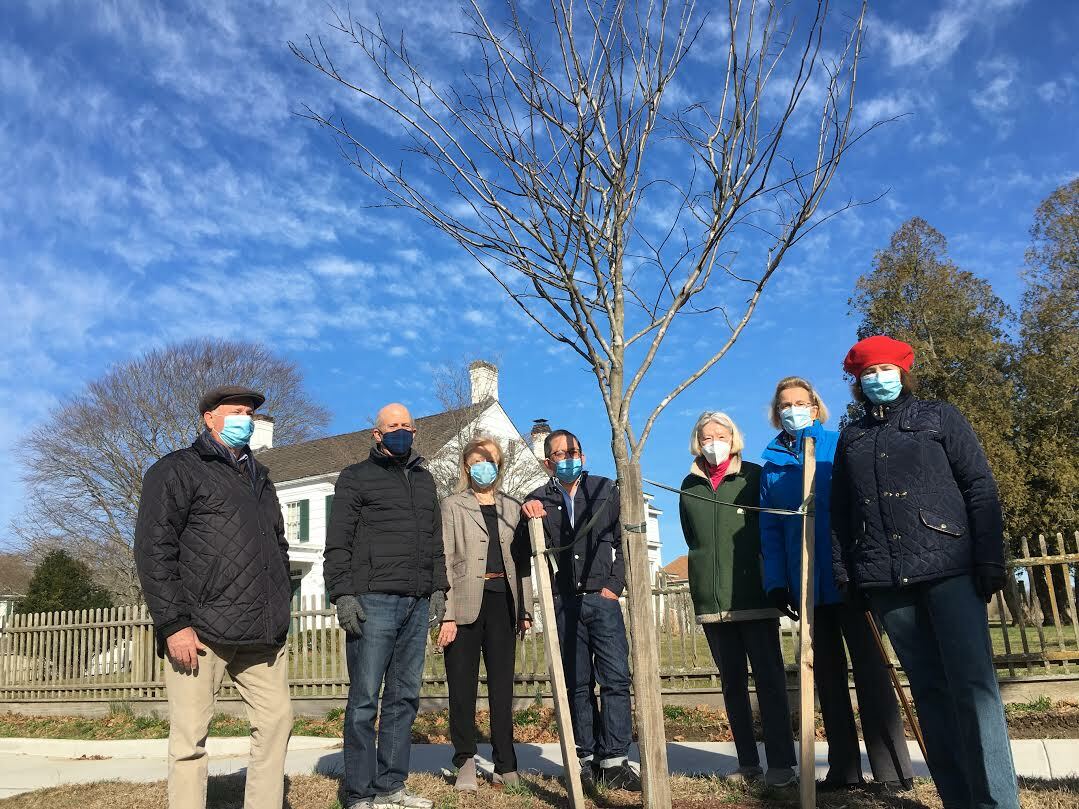
When tree roots on the sidewalk in front of the Corwith House on Main Street in Bridgehampton became a tripping hazard, the Southampton Town Highway Department simply removed the trees.
That removal, in 2018, spurred members of the Bridgehampton Citizens Advisory Committee to start a conversation with town officials about the care of street trees.
When committee members learned, later that year, that there would be money left over in the capital plan for the replacement of trees removed during an extensive overhaul of sidewalks and crosswalks in the hamlet, they formed a committee that spent months researching species and identifying spots for trees.
According to Pamela Harwood, chair of the Bridgehampton CAC, 20 trees were removed in conjunction with the pedestrian safety capital improvement program. Just last year, replacements were planted along Main Street, from the Butter Lane intersection all the way to the monument at the eastern end of downtown.
Ms. Harwood, a member of the board of the Horticultural Alliance of the Hamptons, along with CAC member Alejandro Saralegui, the executive director of the Madoo Conservancy, and Rick Bogusch, the manager of Bridge Gardens and an HAH board member, investigated which species would work best in which locations along Main Street. They worked with Christine Fetten, the director of municipal works for Southampton Town, and Tom Neely, the town’s director of public transportation and traffic safety.
Using New York City’s list of approved “street trees,” the group looked for species native to eastern Long Island. For the northern side of Main Street, they wanted trees that wouldn’t interfere with existing utility lines. They decided upon Eastern redbud, which is short in stature, flowers in the spring and produces colorful fall foliage, and upright European hornbeam, ideal for narrow spaces.
Native red oaks could be placed on the southern side, where there are no overhead lines to interfere with their tall stature.
With the replacements planted, CAC members want to make sure their endeavor is protected and even branches out to other sections of the town.
“This winter, when a CAC member wished to donate a memorial tree in honor of a recently deceased, prominent member of the Bridgehampton community, we followed the same guidelines for selection and location, again on Bridgehampton Main Street, and again working with Ms. Fetten and Mr. Neely for approval and follow-up,” Ms. Harwood said.
“It therefore occurred to us that having a list of approved street trees, selecting native trees where possible, being mindful of their mature height and width and other characteristics, and working with town officials, could be used as the model for selecting, approving and planting trees on public easements.”
Last week, the CAC forwarded a resolution to the Town Board asking lawmakers to create and codify an umbrella policy “for the selection, planting, maintenance and removal of trees along public roadside easements, as well as those along, or overly near to, private property lines between neighbors,” according to the resolution.
“We believe that the value of trees has long been of interest to most of the various environmental, horticultural and civic groups on the East End, but that awareness of their environmental and aesthetic value, and the harm that is done by improper selection, siting, planting and pruning, has never been greater than it is now, and therefore this is a very timely request and discussion,” Ms. Hardwood said.
The community would benefit if the town enacted a policy for the planting and maintenance of trees planted in public spaces, particularly along roadside public easements, the CAC’s resolution noted. The policy would include the selective removal of weakened trees.
Key to deriving the environmental and aesthetic benefit of trees is making sure the right tree is planted at the right time in the right location. Otherwise, an array of negative results could occur: They’ll be too tall for the space and grow through utility lines; they’ll have large roots that damage sidewalks; placed too near a driveway, they’ll block the view of other cars; or the species may drop seed balls that litter sidewalks and the road each fall.
The CAC’s resolution points out that biodiversity among trees lining a roadway is essential. That way, if an illness befalls one species, or a destructive insect targets a particular species, all the trees on the street won’t be impacted.
Speaking to existing trees, the resolution seeks a process for necessary tree removals and suggests that a certified arborist first assess large, old trees. The arborist could craft a report about any tree that might pose a danger to the public or infrastructure, and that report would be shared with neighbors of the targeted tree.
Conversely, there should be a system to follow for residents who need to report a dangerous tree.
When an unhealthy tree is removed the removal should be complete, including the grinding down of the stump.
The process of tree removal should not be arbitrary, the CAC’s resolution and recommendations continue — pruning and watering of newly planted trees should be overseen by the town arborist.
Finally, homeowners and businesses that want to plant trees on easements should obtain a permit and follow guidelines for acceptable street trees.
“The committee has done some fantastic work with Tom Neely and Christine Fetten,” Councilman Tommy John Schiavoni, the Town Board liaison to the hamlet, offered. He feels getting a certified arborist on staff is “a fantastic idea,” if the budget will allow.
He and colleagues are reviewing the CAC’s resolution and will also investigate policies other municipalities have regarding trees.